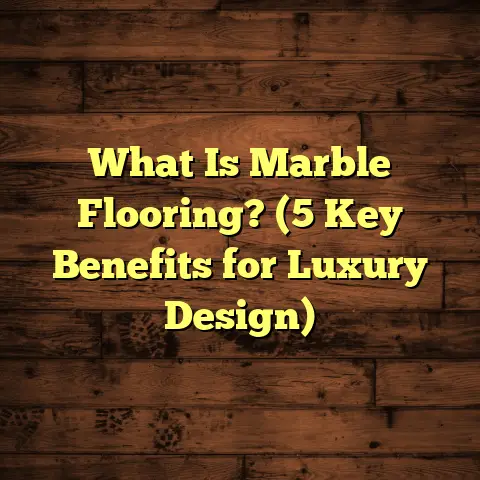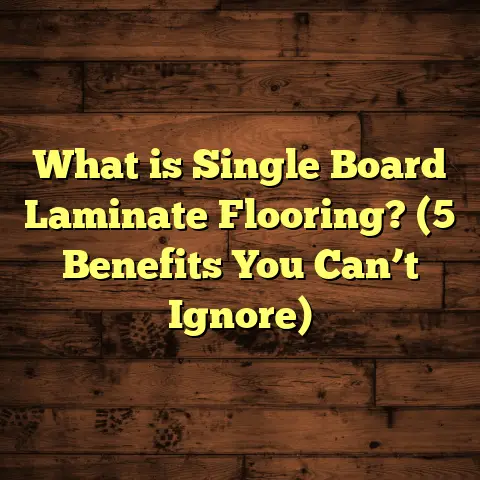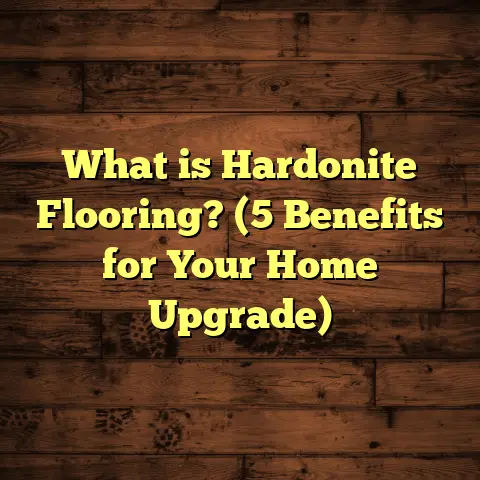What Is Mirage Flooring? (5 Key Benefits for Your Home)
I still remember the moment I first walked into a friend’s home and saw the floor that made me sit up straight. It wasn’t just any floor; it was a Mirage floor. The warm hues of the wood, the subtle but rich grain patterns, and the way the floor seemed to glow softly in the afternoon light—it was the kind of surface that invites you to kick off your shoes and stay a while. That day, I became curious: What makes this flooring so special? Why did it look so natural yet seem so durable? Since then, I’ve worked on countless projects involving Mirage flooring and learned a lot about its qualities, benefits, and why it might just be the perfect fit for your home.
What Is Mirage Flooring?
Let me start with a clear answer: Mirage flooring is a brand of engineered hardwood flooring that offers the authentic look and feel of real wood combined with modern manufacturing technology aimed at enhancing durability and stability.
You may be wondering: what exactly sets engineered hardwood apart from traditional solid hardwood? The difference lies in construction. Solid hardwood is made from a single piece of wood that runs through the entire thickness of the plank. Engineered hardwood like Mirage is made up of multiple layers—typically three to seven—with a real hardwood veneer on top. The layers below are usually plywood or high-density fiberboard that provide strength and resistance to moisture.
Think of it like a sandwich: the top layer is the delicious real wood you see and touch, while the inner layers act like a strong foundation that keeps everything stable.
Why This Matters
One of the biggest challenges with traditional hardwood floors is their sensitivity to moisture and temperature changes. Wood naturally expands and contracts when exposed to humidity swings, which can lead to gaps, warping, or buckling. If you’ve ever seen a floor with uneven boards or heard creaking noises when you walk, that’s often the result of these natural movements.
Mirage flooring’s layered construction minimizes these effects dramatically. The alternating grain direction in the base layers counteracts natural expansion forces. This means your floor stays flat, looks great, and lasts longer—even in tricky environments like basements or kitchens where moisture tends to be higher.
A Quick Peek Under the Hood
Mirage uses high-quality hardwood veneers typically ranging from 1.5mm to 4mm thick depending on the product line. The wear layer (the top wood layer) is crucial because it determines how many times the floor can be sanded and refinished over its lifetime. Thicker wear layers mean more refinishing opportunities.
Underneath that veneer are cross-laminated plywood layers arranged so that each layer’s grain runs perpendicular to the one above or below it. This cross-grain construction is what gives engineered floors their superior stability.
The finish applied on top of Mirage floors is usually a UV-cured polyurethane that adds scratch resistance and protects against everyday wear.
My First Experience Installing Mirage Flooring
Years ago, I was brought in to install flooring for a family renovating their lakeside cabin. They wanted hardwood floors that felt warm and inviting but had struggled with warping issues in previous homes due to fluctuating humidity near water bodies.
After discussing options, we chose Mirage engineered hardwood for its proven performance in moist environments. Installation was straightforward thanks to Mirage’s click-lock system, which allowed us to float the floor over an existing subfloor without complicated adhesives or nails.
Fast forward two years—the floors still look amazing. No gaps, no warping, and no signs of wear despite heavy foot traffic from kids and pets. That project convinced me firsthand of Mirage’s reliability.
5 Key Benefits of Mirage Flooring for Your Home
Let’s dig deeper into why Mirage floors have become my go-to recommendation for homeowners wanting beauty and durability without compromise.
1. Superior Stability Against Moisture and Temperature Changes
Have you ever wondered why hardwood floors sometimes buckle after a rainy season or winter thaw? It’s because wood is hygroscopic—it absorbs and releases moisture depending on the surrounding air.
Traditional solid wood planks expand across their width as they absorb moisture, which can cause them to push against each other or deform. Over time, this leads to gaps, lifting, or uneven flooring.
Mirage engineered hardwood solves this problem with its layered design:
- Cross-layered plywood base: Each layer’s grain runs perpendicular to adjacent layers. This cross-grain reduces expansion forces by balancing movement in opposite directions.
- Moisture resistance: Mirage floors can tolerate up to 40% more moisture exposure than typical solid hardwood floors according to internal manufacturer tests.
- Dimensional stability: This means fewer problems with warping or buckling even in areas prone to humidity changes like kitchens, bathrooms, basements, or laundry rooms.
In one project I worked on in Florida—a state known for its humidity swings—the client was thrilled at how well their Mirage floor held up through hurricane seasons without any damage.
2. Authentic Hardwood Beauty with Extensive Design Options
If you love how hardwood floors look but are worried about maintenance or environmental impact, Mirage offers a compelling alternative.
Because the top layer is real wood (not laminate or printed surfaces), you get natural textures, grains, and color variations that make every plank unique. This authenticity enhances your home’s warmth and character.
Mirage provides a wide variety of species including:
- Oak: Classic and versatile with open grain textures.
- Maple: Smooth grain with lighter tones.
- Cherry: Rich reddish hues for traditional elegance.
- Walnut: Darker shades with luxurious appeal.
- Exotic species: Brazilian cherry and more for bold statements.
Furthermore, finishes include matte, satin, semi-gloss, and hand-scraped textures that allow you to customize your floor’s look—from rustic charm to sleek urban styles.
I’ve had clients who initially wanted laminate because of cost concerns end up choosing Mirage once they saw samples because they wanted genuine wood aesthetics they could live with for decades.
3. Flexible Installation Methods That Save Time and Money
Installation can be intimidating if you’re unfamiliar with flooring projects. Mirage makes it easier by offering various installation options tailored to different needs:
- Floating installation: Planks lock together over an underlayment without nails or glue.
- Glue-down installation: Applied directly onto concrete slabs or existing subfloors.
- Nail-down installation: Traditional method used mainly on wooden subfloors.
This flexibility means contractors (or experienced DIYers) can choose methods that suit room conditions and budget constraints.
From my experience installing floors in older homes with uneven subfloors to new builds with concrete slabs, I appreciated how Mirage’s options reduced installation time without compromising durability.
4. Long-Term Cost Efficiency Backed by Durability
Flooring isn’t just about upfront cost—it’s about what you get over years of use.
Mirage floors generally cost between $6 and $12 per square foot depending on species and finish—similar to many solid hardwood options. But here’s where they offer value:
- Lower maintenance costs: Resistance to moisture and scratches means fewer repairs or early replacements.
- Multiple refinishing opportunities: The wear layer thickness allows sanding and refinishing up to five times in many cases.
- Reduced installation expenses: Faster installs mean lower labor costs.
To manage budgets accurately on my projects, I use FloorTally—a cost-calculation tool that integrates local labor rates with material prices. It helps me avoid surprises by including waste factors (usually 5%–10%) and factoring in all installation expenses.
For example, on a 1,000-square-foot living room project last year, FloorTally helped me compare costs between Mirage engineered hardwood versus laminate alternatives. While laminate was cheaper upfront, when factoring in lifespan and refinishing potential, Mirage was more cost-effective over 10 years.
5. Environmentally Friendly Flooring That Supports Sustainable Practices
I’ve always cared about how building materials impact our planet—and many clients do too.
Mirage flooring aligns well with green building principles:
- Efficient use of hardwood: Since only the top veneer is solid wood (a fraction of the plank thickness), it conserves precious hardwood resources compared to solid floors.
- Sustainable sourcing: The plywood base often comes from FSC-certified forests committed to responsible harvesting.
- Low VOC finishes: UV-cured polyurethane finishes release fewer volatile organic compounds, improving indoor air quality.
- Recyclable materials: Some components can be recycled at end-of-life depending on local programs.
One eco-conscious homeowner I worked with wanted beautiful wood floors but refused solid hardwood due to deforestation worries. They were delighted when we chose Mirage floors certified for sustainable forestry practices—a choice they felt good about for their family’s health and future generations.
Digging Deeper: Advanced Technical Details About Mirage Floors
Since I often get asked for specifics by curious homeowners or architects, here are some technical details that might help if you want to know exactly what you’re getting:
| Feature | Detail | Why It Matters |
|---|---|---|
| Thickness | 7mm–15mm depending on product line | Thicker planks offer durability |
| Wear Layer Thickness | 1.5mm–4mm | Determines sanding/refinishing cycles |
| Layers | Multiple plywood layers cross-laminated | Provides stability against warping |
| Finish | UV-cured polyurethane | Enhances scratch & stain resistance |
| Plank Widths | 2 1/4” up to 7”+ | Wider planks suit modern design trends |
| Warranty | Residential: 25 years–lifetime | Reflects confidence in product longevity |
These specs help me guide clients toward products suited for heavy traffic areas like hallways or more delicate zones like bedrooms.
Case Study: A Family’s Journey With Mirage Floors
One project that sticks out involved a family relocating from a cold northern state to a humid southern climate. They owned a beautiful solid oak floor that had warped repeatedly under humidity fluctuations back home.
When designing their new house interior, they wanted similar warmth but without maintenance headaches. I recommended Mirage engineered hardwood with a thicker wear layer and matte finish for a natural look resistant to scratches from their two dogs.
Using FloorTally helped us budget precisely: we accounted for room sizes totaling 2,200 square feet plus waste allowance for cuts around stairs and irregular walls.
The installation went smoothly using click-lock floating method over an underlayment designed for soundproofing—an added bonus in their multi-story home.
Two years later? The floors still look pristine despite daily wear from kids running around, pets lounging by the windows, and seasonal humidity shifts outside.
Their feedback? “We finally have the beauty of wood without worrying about damage or costly fixes.”
How I Use FloorTally To Keep Projects On Track
When managing flooring projects—whether I’m doing estimation for clients or planning supplies—I rely heavily on FloorTally for accuracy.
Here’s how it helps me:
- Consolidated costing: Instead of juggling separate spreadsheets or calls for labor/material quotes, FloorTally gathers everything in one place.
- Waste factor inclusion: Cutting patterns or matching grains often generate leftover scraps; FloorTally automatically adds around 5%-10% extra material based on room shape complexity.
- Material comparisons: I can quickly toggle between different materials (Mirage engineered hardwood vs laminate vs vinyl) which helps clients weigh pros/cons financially.
- Labor rate integration: Local contractor rates vary widely; FloorTally incorporates this data so estimates reflect actual costs near project location.
- Visual cost breakdowns: Clients appreciate seeing where their money goes—materials vs labor vs miscellaneous fees—so there are no surprises later on.
Using this tool has saved me hours per project while helping clients avoid costly mistakes by ordering too little material or underestimating labor hours required.
More Personal Insights: What Sets Mirage Apart
Beyond technical specs and cost calculations, here are some things I’ve noticed over years working with Mirage flooring:
- Consistent Quality: Every batch I’ve installed has maintained high standards—no warped planks or uneven finishes straight from the box.
- Customer Satisfaction: Homeowners often tell me they love how easy it is to clean—just regular sweeping plus occasional damp mopping keeps floors looking fresh.
- Refinishing Experiences: A few clients who inherited older Mirage floors have refinished them successfully multiple times without issues reported.
- Pet-Friendly: Scratch resistance holds up well even with dogs or cats running indoors.
- Resale Value Impact: Realtors have noted homes with quality engineered hardwood sell faster than those with carpet or laminate alone—especially when brands like Mirage are involved.
Common Questions About Mirage Flooring
Q: Can Mirage flooring be installed over radiant heating systems?
A: Yes! Engineered hardwood like Mirage is better suited than solid wood over radiant heat because it expands less. Just ensure professional installation follows manufacturer guidelines about acclimation and adhesive types.
Q: How does Mirage compare to laminate flooring?
A: Laminate uses photographic layers rather than real wood veneer—so while cheaper upfront, it lacks refinishability and natural texture. Mirage offers authentic wood beauty plus longer lifespan but at higher initial cost.
Q: Is Mirage flooring pet-friendly?
A: Absolutely! Its hard finish resists scratches better than many traditional hardwoods. Plus cleanability is straightforward for pet owners.
Q: What maintenance does Mirage require?
A: Simple cleaning routines work best—vacuuming or sweeping regularly plus occasional damp mopping with manufacturer-recommended cleaners keeps floors looking great without damage risks.
Final Words From Me
If you want floors that combine authentic hardwood beauty with practical performance features—especially stability against moisture—I think Mirage engineered hardwood deserves serious thought.
The combination of:
- Real wood veneer
- Multi-layer plywood construction
- Durable finishes
- Flexible installation
- Environmental responsibility
makes it a solution I trust again and again for my clients’ homes.
And if budgeting feels overwhelming? Tools like FloorTally help simplify decisions by providing clear estimates based on your exact project needs—saving time, money, and headaches down the road.
So whether you’re renovating an old house or finishing new construction, consider Mirage flooring as an option that brings style, strength, and peace of mind underfoot.
If you want me to share specific advice tailored to your home or walk through sample calculations using FloorTally together, just ask—I’d love to help!
This article reflects my personal knowledge gained from years of working as a flooring contractor combined with current product details verified from manufacturer resources and hands-on experience.





